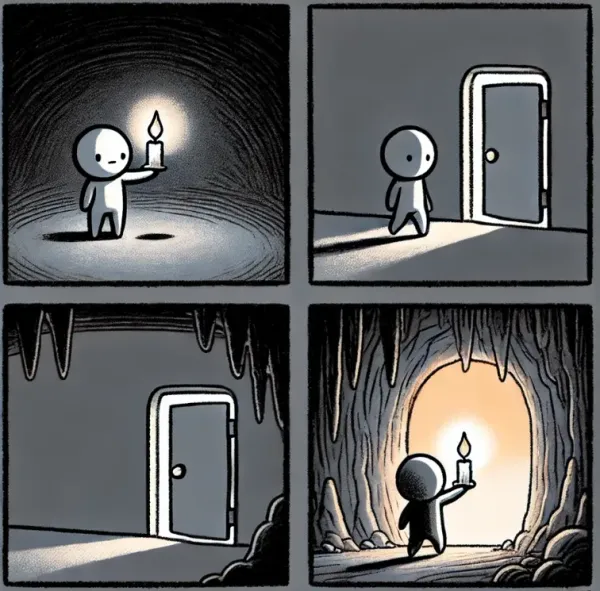Our Unspoken Future
Why do we have to keep re-reading the same three articles?

“No problem can be solved from the same level of consciousness that created it.”
- Einstein

The Fourth Yearning
Most current analysis of our world seems to produce endless variations on the same three themes:
- Doomers. “Things used to be great. But now they’re terrible and getting worse. No, I don’t have any solutions.” (Typically finance, culture and politics opinion writers)
- “Exponential technology will save us, just wait until we invent nuclear fusion, Artificial General Intelligence or space travel.” (Typically venture capitalists or “thought leaders” employed by VCs).
- “Put down your phone, go outside and touch grass. Everything from infant mortality to global poverty is trending positively in the long term.” (TED Talks and “trends guys” like Hans Rosling or Steven Pinker)
All three of these contain truth, but they neglect a fourth factor. It’s what’s not being talked about that’s most interesting. They’re all analysing the ocean’s tides, but never once discussing the hidden influence of the moon.
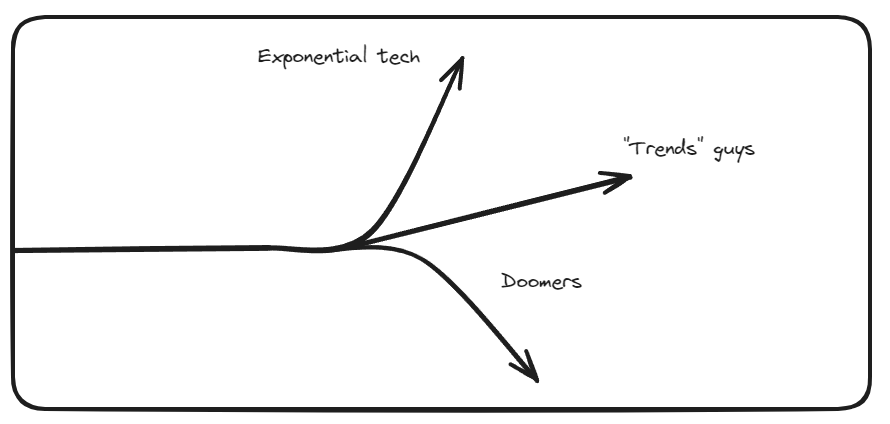
The Meta-Cause of the Meta-Crisis
It is unquestionably the case that humanity dominates the world because of our ability to coordinate in increasingly massive numbers. In the long term, cooperation is the most evolutionarily successful strategy. More cooperative tribes would outcompete and kill less cooperative ones. We’ve since progressed from villages, to cities to nation-states. These now allow for cooperation at a planetary scale. But international cooperation still allows for international conflict. Recent events have demonstrated that the age of large-scale war is far from behind us. Moreover, relying on the threat of nuclear armageddon to force international cooperation is like removing the safety net to make you more focused on the tightrope.
The doomers are right: we are currently failing to cooperate at the scale needed to solve our problems. The techno-utopians are also right: we can potentially coordinate to develop transformational tools to solve our problems. And the trends guys are also right: historically we’ve been great at finding ways to improve our overall circumstances.
But these outcomes all hinge on the meta-cause of the meta-crisis: human consciousness. The only frontier left beyond international cooperation is species-level cooperation. Historically, it has been physical conflict that has led to greater cooperation. The Germans, Japanese and Italians discovered as much as recently as World War Two. The “Great Peace” that has followed has been truly unprecedented.
Now we’re operating at a planetary scale, the next conflict is primarily about mindset; it’s within ourselves. When you reflect for a minute, it’s incredible to realise how many of our hardest problems are almost entirely coordination problems. For example:
- Politics (cooperate to pass legislation and rebuild effective institutions).
- War (agree not to kill each other).
- Environment (agree not to kill everything else).
- Innovation (collaborate on technological invention).
- Hunger (getting our abundant food where it’s needed).
- Inequality (allocate resources more equally).
Our current track record on most of those is poor and getting worse. This is the primary reason Dr. Iain McGilchrist’s hemisphere theory is so spectacular.1 He argues persuasively that the modern world is neurologically imbalanced towards the brain’s left hemisphere. This makes us excessively competitive and paranoid. As he notes: “the right hemisphere is engaged in social bonding and empathy, the left hemisphere in social rivalry and self-regard.” The ideal balance is stable competition within a broader cooperative framework: e.g. capitalism at its finest.
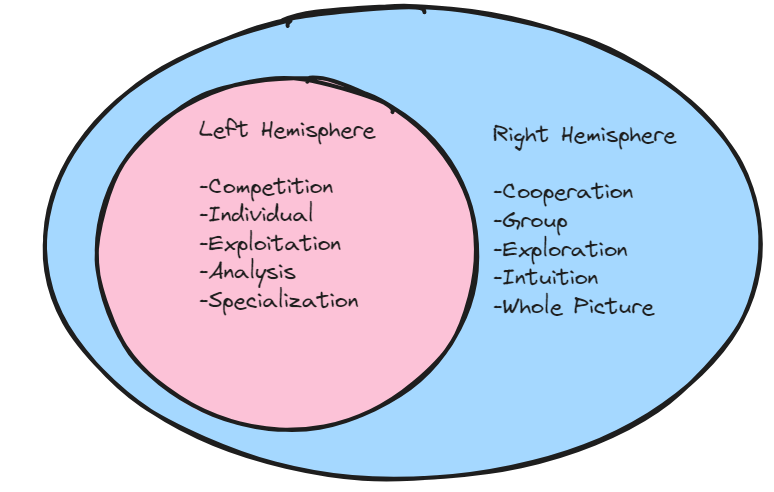
One reason that this topic is so taboo is because talking about a “global paradigm shift in consciousness” has the unfortunate side-effect of making you sound like a naive hippy.
Why would we all just spontaneously agree to get along?
There’s both a macro and micro vision.
The Macro Vision: “It’s the Anomaly, Stupid”
"You never change things by fighting the existing reality. To change something, build a new model that makes the existing model obsolete."
- R. Buckminster Fuller
The internet has finally provided the mechanism for global coordination beyond nation states, we just lack the collective mindset and motivation.
In financial markets, sudden spikes of connectivity can precede phase changes.2 We’ve just had the sudden spike in connectivity, the phase change in consciousness might be next. Phase changes in any complex adaptive system, including societies, tend to follow the same archetypal pattern (described in the ubiquitous human story, the hero’s journey). We have no reason to believe things will be different this time.
An incomplete model encounters an anomaly. The flaws in the model create dissonance, which eventually breaks the existing frame. The model incorporates the anomaly and emerges in a more complete and complex form.
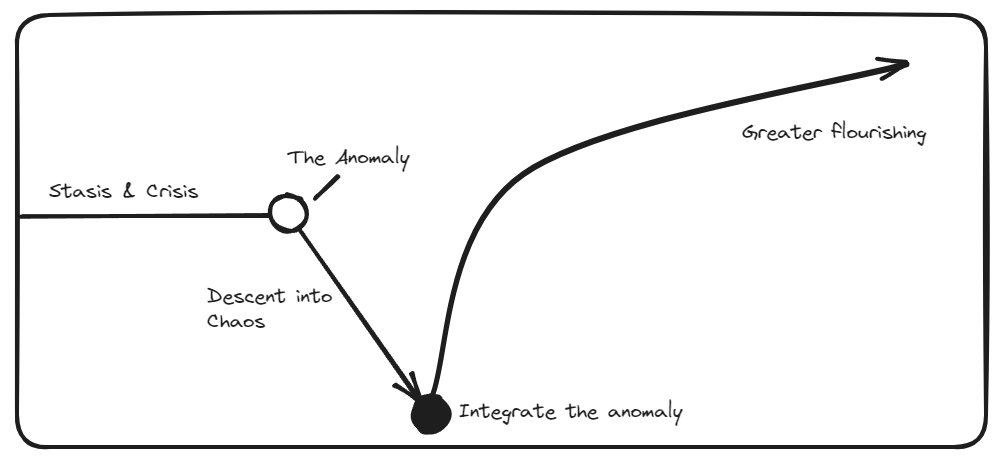
The wild thing is, we know what the anomaly might be! For over a century we’ve had increasingly obvious signs that consciousness isn’t confined to our skulls. Our brains probably don’t contain consciousness any more than your radio contains Taylor Swift. Moreover, as we continue to learn the extent to which consciousness isn’t bound by time or space, it gets harder to regard ourselves as truly separate from other people. Instead of treating other people like NPCs in Grand Theft Auto, we will increasingly see them as extensions of ourselves.
How would we know if this mindset shift towards cooperation is actually happening right now? Our right hemisphere leads our exploratory attention, so you can predict the future by observing what broader society is becoming interested in. Cultural historian Richard Tarnas has convincingly itemized more than thirty different signs of this resurgence.3 Taken as a whole, we can see the return of the right hemisphere reflected in the increasing popularity of psychedelics, yoga, meditation, breath-work, embodiment and the expansion of consciousness in general. Moreover, the broader focus on diversity, equality, sustainability and responsible investing (especially in the younger generation) can be seen as an early stumbling back into a more balanced world. What’s especially interesting is that the Internet can propagate these ideas and social movements almost instantly. The unspoken is finally being spoken.
However, it just doesn’t seem realistic to argue that even a sudden macro-level acceptance of an entirely new theory of consciousness is going to motivate a global change in cooperative behavior.
We already have the mechanism, if we then have the mindset, what’s the motivation?
The Micro Vision: An Optimal Path.
There is something in nature that moves towards information, towards complexity, towards structure. If we are decoherent, if we destroy, we are acting against the natural flow of things. And that is immoral almost in a cosmic, in a natural sense.
- Ervin Laszlo
The knowledge what we’re all connected by the same consciousness is likely necessary but not sufficient. It doesn’t tell you what to do next, how to act. Or why it’s worth it. Thankfully there’s increasingly abundant scientific evidence that there’s a direction to the universe, towards coherence and complexity. If consciousness isn’t simply restricted to the “inside” of us, it can be guiding us from the “outside.” The force behind this is what systems theorist Ervin Laszlo calls the “holotropic attractor.” The attractor breaks the incentive to cheat by demonstrating that it’s optimal for you as an individual to cooperate rather than compete. Why?
The attractor drives both differentiation and integration: complexity. Our bodies are the perfect example: an infinite number of differentiated parts that are somehow integrated to create a coherent, emergent thing. The pursuit of differentiation, our own unique niche, feels meaningful, and puts you in flow. It makes total sense that evolution would make superior strategies feel better. Meanwhile integration results in positive environmental feedback and meaningful coincidences. Our gifts need to serve something larger. The resulting dynamic balance makes us less comparative, acquisitive and competitive. Zero-sum games are energetically limited to one-off winners and losers. Positive-sum games are infinitely joyful. It’s the difference between a fleeting moment of victory and the lifetime enjoyment of playing a game for its own sake. A positive-sum game is competition within a broader cooperative framework.
We are indeed free to take virtually any direction we want in life, but it’s myth that points us towards this ideal path. This is why the study of myth is the ultimate information alpha. The overly literal and reductive left hemispheric mindset thinks they're fantasies about orcs and fairies, when actually they're about the hidden structures of deep reality. They encode the different ways humans have watched each other succeed and fail for hundreds of thousands of years.
This fractal monomyth, the Hero’s Journey, is the story that humans tell to describe how to participate in the process of complexification as individuals. We encounter the anomaly: a new understanding of consciousness. This presents the reality of a force that’s superior to our egocentric perception of the world, and then forces us to surrender control to it. A death and rebirth switches our locus of control from the left hemispheric ego to a right hemisphere that’s significantly more connected to this emergent force.
Another ubiquitous myth “be careful what you wish for”, describes how we stray from that path when we try to overpower evolution with our narrow egos. This is what we’ve currently done as a society, with disastrous consequences for the global environment.
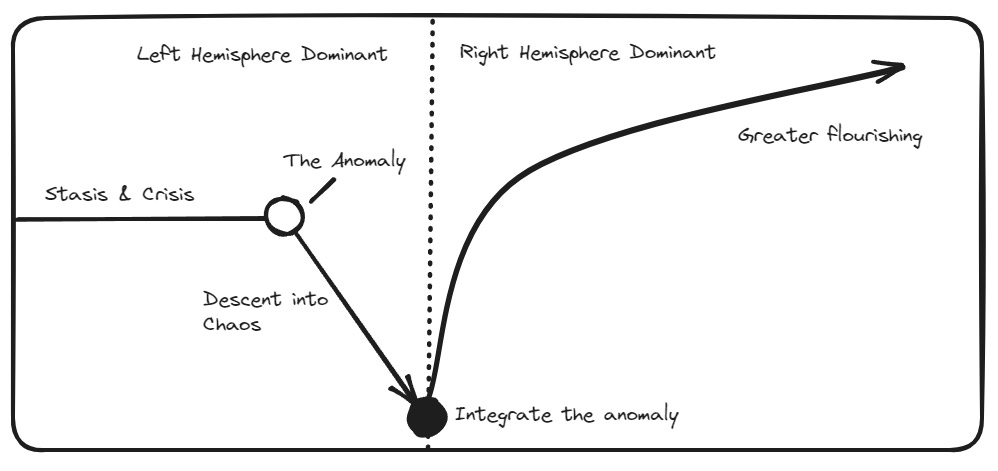
"It doesn't look like anything to me."
In the TV show Westworld, the robotic hosts would sometimes accidentally be exposed to anomalies that revealed the artificial nature of their world. They would simply stare blankly and repeat: "It doesn't look like anything to me."
The left hemisphere will never be able to anticipate its own decline. It’s why all of the articles produced by left-hemispheric industries like tech and finance read the same. It’s endless reductive diagnosis, few solutions and scarcely any discussion of consciousness at all. They can reduce the trees down to splinters and still miss the forest. They are the “experts” least able to detect this kind of phase shift. This is because there’s one specific point beyond which many intellectuals simply won’t go. The more rationalist someone is, the harder it is for them to consider that there may be an intelligence to our environment that we can enter into relationship with. The brain’s left hemisphere lies, confabulates and protects its dominion. The right doesn’t. The limitations of our culture and neurology mean we cannot see it is our mindset itself that’s the primary obstacle.
If the left hemisphere can’t even see the unseen, it can never speak the unspoken. So that role is reserved for the prophet. They had to “die for the sins” of the tribe and take the anomaly into themselves first. That difficult return to intuition was, above all, for the benefit of rebalancing a community that had gone astray. They deliver that perennially unpopular message, one that can get you mocked, ostracised or burned at the stake. As Jung anticipated, this means modern prophets now have to straddle both hemispheres; science and mysticism. This allows them to speak the unspoken in a safer way that can be heard by more people.
Even more compellingly, ~99% of humanity before us, and many outside of the West today, already live in a world that integrates this “intuitive anomaly” in the service of balancing their culture (see the Emerald podcast below). Despite the fact that somewhere around half of Americans report having had a mystical experience,4 the topic remains woo taboo here. But when technology allows us to realise how widespread these experiences actually are, and how scientifically valid they are, the anomaly becomes common knowledge. Then you can get the phase shift.
The first step is being more open to exploring and talking about “the anomaly.” The second step is acting as if it might be true. Start by respecting the divinity of your curiosity and responsive reality may react in a way that shows you it’s watching.
Related Listening.
- Listen: My interview on What Got You There with Sean DeLaney (1 hour 10 minute listen)
- Why listen: If you look at the calibre of Sean’s other guests you’ll see why I was so grateful to be invited onto his pod! He’s a great interviewer. We discussed the concept of curiosity as a direct connection to the anomaly, the role of suffering in growth and the economic opportunity from building a modern wisdom school.
Listen: Peter Kingsley with Michael Lerner Finding What is Real (2007) and The Great Taboo (2011).
Why listen: These two old lectures are some of the small number of Peter Kingsley’s interviews available for free online. His book Catafalque is one of the best I’ve read in years. I just finished A Book of Life this week and his book Reality is next. Not only does Catafalque reveal the extent to which Carl Jung was a scientific-prophet, there are more than a few indications Kingsley is a living prophet of sorts himself. His fascinating work explores the lost Western sacred tradition. In reference to “the anomaly,” he argues that Parmenides’ work was trying to prove that all is one. Moreover the idea central to Kingsley’s work is letting nature work through you, using the Greek concept of “metis.” He describes this in more detail in an excellent 80 minute paywalled lecture.
Metis is not just about finding the unchanging reality hidden behind the scenes of everyday existence. It also involves learning how to navigate that existence and function effectively inside it.
Listen: For the Intuitives (Part 1) by the Emerald (1 hour 37 minute listen)
Why Listen: The unusual form of this podcast can be a bit long and repetitive. But if you want to listen to something that’s a truly fresh perspective, this is it. Schrei reveals that intuitive gifts we think of as either woo or unique is simply how 99% of humanity thinks outside of the Western world. Moreover, now we either try to demonise or monetize intuition when (like Kingsley) he argues that the highest use was always for the benefit of our whole culture, the whole tribe.
The proclivity towards vilifying and pathologizing intuition on the one hand and claiming it as an exotic and monetizable gift useful for attracting internet followers on the other — all of this is a function of the othering of intuition in the modern world. Societally, we would do well to rediscover the central role of the seer. For if we lose our ability to learn from the visions of seers, we lose the feeling body of culture — the very thing that drives culture forward.
The information provided is for educational and informational purposes only and does not constitute investment advice and it should not be relied on as such. It should not be considered a solicitation to buy or an offer to sell a security. It does not take into account any investor’s particular investment objectives, strategies, tax status or investment horizon. You should consult your attorney or tax advisor.
The views expressed in this commentary are subject to change based on market and other conditions. These documents may contain certain statements that may be deemed forward looking statements. Please note that any such statements are not guarantees of any future performance and actual results or developments may differ materially from those projected. Any projections, market outlooks, or estimates are based upon certain assumptions and should not be construed as indicative of actual events that will occur.
Here, in the world’s longest sentence, is a powerful encapsulation of this thesis from McGilchrist himself: ‘I would contend that a combination of urban environments which are increasingly rectilinear grids of machine-made surfaces and shapes, in which little speaks of the natural world; a worldwide increase in the proportion of the population who live in such environments, and live in them in greater degrees of isolation; an unprecedented assault on the natural world, not just through exploitation, despoliation and pollution, but also more subtly, through excessive ‘management’ of one kind or another, coupled with an increase in the virtuality of life, both in the nature of work undertaken, and in the omnipresence in leisure time of television and the internet, which between them have created a largely insubstantial replica of ‘life’ as processed by the left hemisphere — all these have to a remarkable extent realised this aim, if I am right that it is an aim, in an almost unbelievably short period of time.’ ↩
As MIT’s Andrew Lo wrote in his book Adaptive Markets: “Immediately before and during a financial crisis, the number of statistically significant linkages between firms would double or nearly triple. Everything became much more interconnected in the run-up to a system-wide financial crisis, whether we studied the collapse of LTCM or the subprime crisis.” ↩
Richard Tarnas’ evidence for the return of the right hemisphere: “The crisis of modern man is an essentially masculine crisis, and I believe that its resolution is already now occurring in the tremendous emergence of the feminine in our culture: visible not only in the rise of feminism, the growing empowerment of women, and the widespread opening up to feminine values by both men and women, and not only in the rapid burgeoning of women's scholarship and gender-sensitive perspectives in virtually every intellectual discipline, but also in the increasing sense of unity with the planet and all forms of nature on it, in the increasing awareness of the ecological and the growing reaction against political and corporate policies supporting the domination and exploitation of the environment, in the growing embrace of the human community, in the accelerating collapse of long-standing political and ideological barriers separating the world's peoples, in the deepening recognition of the value and necessity of partnership, pluralism, and the interplay of many perspectives. It is visible also in the widespread urge to reconnect with the body, the emotions, the unconscious, the imagination and intuition, in the new concern with the mystery of childbirth and the dignity of the maternal, in the growing recognition of an immanent intelligence in nature, in the broad popularity of the Gaia hypothesis. It can be seen in the increasing appreciation of indigenous and archaic cultural perspectives such as the Native American, African, and ancient European, in the new awareness of feminine perspectives of the divine, in the archaeological recovery of the Goddess tradition and the contemporary reemergence of Goddess worship, in the rise of Sophianic Judaeo-Christian theology and the papal declaration of the Assumptio Mariae, in the widely noted spontaneous upsurge of feminine archetypal phenomena in individual dreams and psychotherapy. And it is evident as well in the great wave of interest in the mythological perspective, in esoteric disciplines, in Eastern mysticism, in shamanism, in archetypal and transpersonal psychology, in hermeneutics and other non-objectivist epistemologies, in scientific theories of the holonomic universe, morphogenetic fields, dissipative structures, chaos theory, systems theory, the ecology of mind, the participatory universe--the list could go on and on. As Jung prophesied, an epochal shift is taking place in the contemporary psyche, a reconciliation between the two great polarities, a union of opposites: a hieros gamos (sacred marriage) between the long-dominant but now alienated masculine and the long-suppressed but now ascending feminine.” ↩




